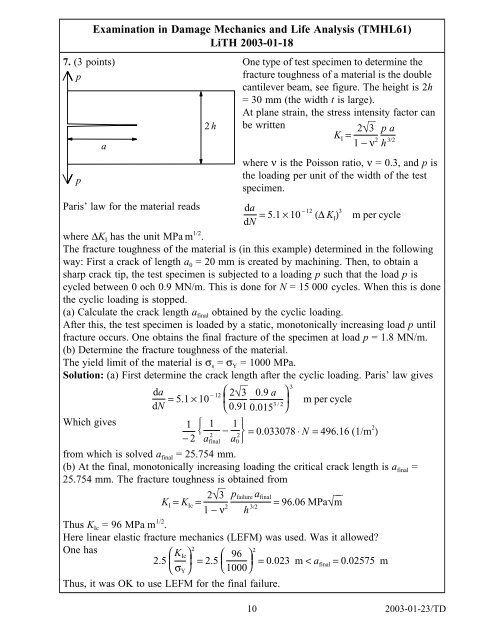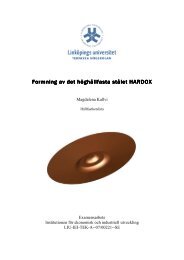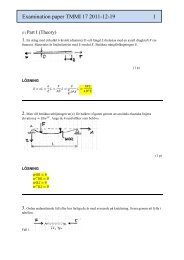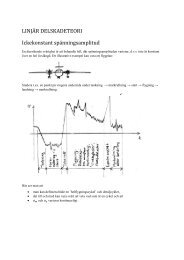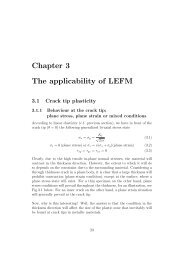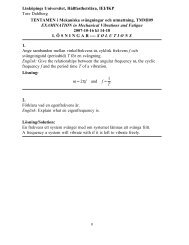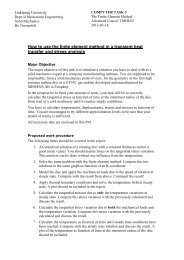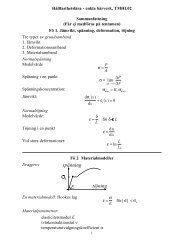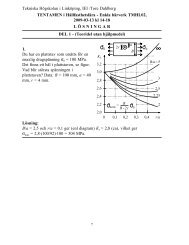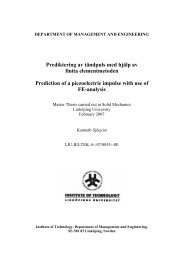2003-01-18 - Division of Solid Mechanics
2003-01-18 - Division of Solid Mechanics
2003-01-18 - Division of Solid Mechanics
Create successful ePaper yourself
Turn your PDF publications into a flip-book with our unique Google optimized e-Paper software.
Examination in Damage <strong>Mechanics</strong> and Life Analysis (TMHL61)<br />
LiTH <strong>2003</strong>-<strong>01</strong>-<strong>18</strong><br />
7. (3 points) One type <strong>of</strong> test specimen to determine the<br />
p<br />
fracture toughness <strong>of</strong> a material is the double<br />
cantilever beam, see figure. The height is 2h<br />
= 30 mm (the width t is large).<br />
At plane strain, the stress intensity factor can<br />
2 h be written<br />
p<br />
a<br />
where ν is the Poisson ratio, ν = 0.3, and p is<br />
the loading per unit <strong>of</strong> the width <strong>of</strong> the test<br />
specimen.<br />
Paris’ law for the material reads da<br />
dN = 5.1 × 10 − 12 (∆ K I ) 3<br />
m per cycle<br />
where ∆K I has the unit MPa m 1/2 .<br />
The fracture toughness <strong>of</strong> the material is (in this example) determined in the following<br />
way: First a crack <strong>of</strong> length a 0 = 20 mm is created by machining. Then, to obtain a<br />
sharp crack tip, the test specimen is subjected to a loading p such that the load p is<br />
cycled between 0 och 0.9 MN/m. This is done for N = 15 000 cycles. When this is done<br />
the cyclic loading is stopped.<br />
(a) Calculate the crack length a final obtained by the cyclic loading.<br />
After this, the test specimen is loaded by a static, monotonically increasing load p until<br />
fracture occurs. One obtains the final fracture <strong>of</strong> the specimen at load p = 1.8 MN/m.<br />
(b) Determine the fracture toughness <strong>of</strong> the material.<br />
The yield limit <strong>of</strong> the material is σ s = σ Y = 1000 MPa.<br />
Solution: (a) First determine the crack length after the cyclic loading. Paris’ law gives<br />
Which gives<br />
da<br />
dN = 5.1 × 10 ⎛ 3<br />
− 12 2√⎺3 0.9 a ⎞<br />
⎜ ⎟⎠ ⎝ 0.91 0.<strong>01</strong>5 3 / 2<br />
1 ⎧<br />
− 2<br />
from which is solved a final = 25.754 mm.<br />
(b) At the final, monotonically increasing loading the critical crack length is a final =<br />
25.754 mm. The fracture toughness is obtained from<br />
K I = K Ic = 2 √⎺3 p failure a final<br />
= 96.06 MPa√⎺m<br />
1 − ν 2 h 3/2<br />
Thus K Ic = 96 MPa m 1/2 .<br />
Here linear elastic fracture mechanics (LEFM) was used. Was it allowed?<br />
One has<br />
2.5 ⎛ 2<br />
K Ic ⎞<br />
⎜ ⎟⎠ = 2.5 ⎛ 2<br />
96 ⎞<br />
⎜ ⎟ = 0.023 m < a ⎝ σ Y ⎝ 1000⎠<br />
final = 0.02575 m<br />
Thus, it was OK to use LEFM for the final failure.<br />
⎨<br />
<br />
a final<br />
m per cycle<br />
K I = 2 √⎺3<br />
1 − ν 2 p a<br />
h 3/2<br />
1<br />
− 1 ⎫<br />
⎬<br />
2 2<br />
a = 0.033078 ⋅ N = 496.16 0 ⎭ (1/m2 )<br />
10 <strong>2003</strong>-<strong>01</strong>-23/TD


